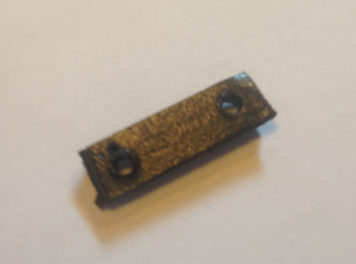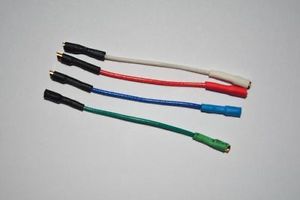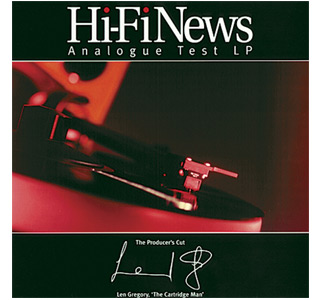The needle should be at the correct distance from the tonearm’s bearing. Thorens provided a headshell gauge as a guide for mounting the cartridge on the stock TP-60 mounting shell. Both the TP-16 and the TP-11 tonearms mounted on the TD-160 (the one I currently have) and the TD-165 (the one I owned before) turntables, respectively, have a TP-60 shell. I don’t have such a headshell gauge, so I calculated the key distances from the scale drawing on the TD-165 manual:

from my calculations, the needle has to be at about 24-25 mm in vertical from the headshell’s outer edge and 7-8 mm (better lower it down to 4-5 mm – as better explained in the cartridge alignment page) horizontally from it (click on the picture at right for an enlarged drawing). With additional patience, it is quite easy take those measurements while the headshell has been removed and placed upside-down on a table. It is as simple as aligning the cartridge by sliding it back and forth until we measure the correct needle position.
On vintage Thorens turntables the problem is that often cartridges are not high enough and their stylus will always be less than 24mm from the ‘roof’ of the cartridge mount. You have to use shims (spacers). There are some special ones on the market but I couldn’t find them easily so I solved it in a “handmade” way: some 3 mm thick, smooth (maybe black) Lego bricks can work for this purpose. Even better, obtain them from PVC sheets or other 3 mm material (top left). It is often difficult to find the right length of screws to tighten the head including the spacers’s thickness. There are commercially available sets of non-magnetisable screws and washers for mounting heads on Thorens shells.
Actually, what really counts is the position of the tip of the reading diamond in relation to the arm length, the so-called effective length. The vertical “height”, i.e. the 24mm distance from the top surface of the headshell, is necessary to avoid any intervention on the height of the tonearm itself. To prevent users from manipulating it, Thorens opted at the time to provide spacers to prevent the arm from being too high at the tail and low at the head (down towards the cartridge) rather than almost horizontal. After a long period of using the above shims I stopped doing so, preferring direct contact between cartridge body and hedashell. By adjusting the arm height appropriately I can settle for an acceptable slope of the arm towards the cartridge.
In short, once you have screwed the head to the headshell without tightening it too much (so that it can be easily moved) it is good to position it so that the diamond tip is 4-5 mm from the front outer edge of the headshell. A protractor is however necessary for a final check. It is very important the needle is at the correct position along the tonearm and that the cantilever, or at least the body, is correctely aligned. There are several different thoeries about the correct alignment of a cartridge along a tonearm (see the alignment page). On a Thorens, the tonearm will certainly be sloping towards the headshell too much. Therefore it will be necessary to lower the tonearm‘s pivot and consequently recheck the VTF.
A very useful upgrade everybody should do on all old Thorens headshells is replacing the 4 leads that connect the cartridge to the tonearm. The original ones are very thin and the contacts are dirty and rusty. As a first step, it is a good idea to remove them and polish all contacts – even the old leads’ – with de-oxi fluid and a small brush.But they should be replaced as soon as possible. Several types of substitute leads are available on the market. They are compatible with almost every headshell around. Some cost a fortune, but I managed to find good, gold plated terminals for just a few euros. I didn’t expect such a good result: it was as if the classical “veil” had been removed from the music.
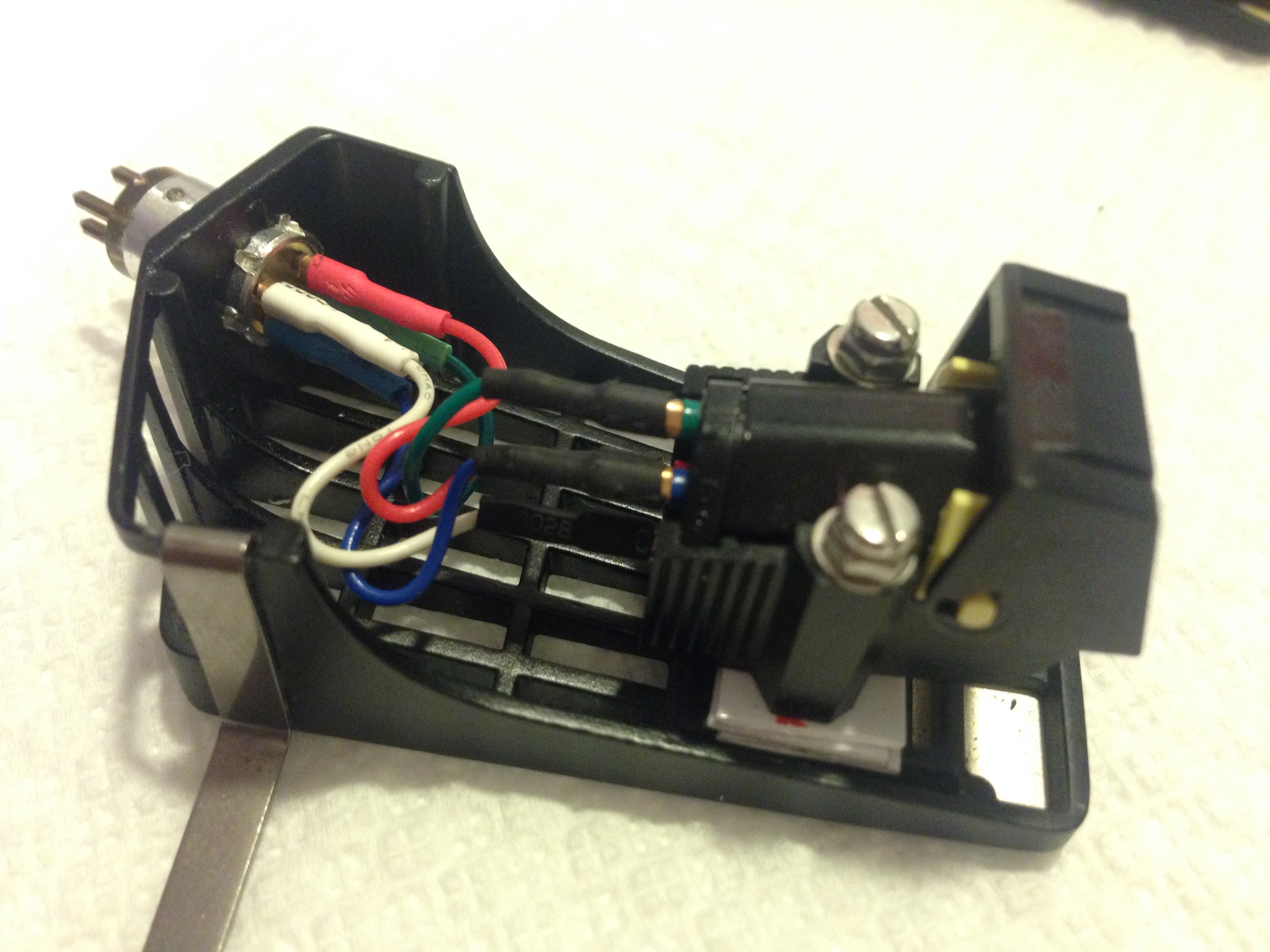
A Shure cartridge mounted in a Thorens TP60 headshell with new leads and home-made spacer.
The leads are thicker than the originals, so they weigh more (0.18 g each); this affects the tonearm/cartridge assembly’s resonance frequency, since I have a heavy arm and a rather compliant stylus. In order to lighten the arm a bit, I removed the Thorens logo plate and a small piece of plastic form within the headshell. Remember that the TP-60 has a different wiring schematics than the standard. Follow the picture at left as a guidance if you choose to replace the headshell leads.
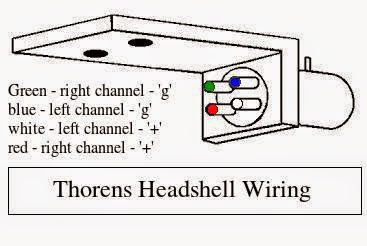 According to the usual mathematical formula, I didn’t obtain an optimal relationship, but I didn’t notice tracking problems or background noises. Then I purchased the very useful HiFi News Test Record.
According to the usual mathematical formula, I didn’t obtain an optimal relationship, but I didn’t notice tracking problems or background noises. Then I purchased the very useful HiFi News Test Record.
It contains several tracks with different signals useful to verify the correct tonearm/cartridge interaction. A really useful track is that for verifying the resonance frequency of the arm/cart system. What really surprised me was that the frequency I obtain mathematically for my TP-16 tonearm and Grado Prestige Gold cartridge is around 7.5 Hz. The optimal range according to HiFi News is 8-15 Hz. The Test Record’s track gives a resonance frequency of around 13 Hz, far better than mathematical forecasts.
Another interesting track is the one considered to be a torture even for high-rated systems. To my great surprise, after having optimized the alignment thanks to the test record itself, my Grado Prestige Gold with 8MZ stylus passed even the terrible test: it stayed in the grooves. It seems that even the acclaimed tracker Shure V15 VxMR TNT-Audio’s Geoff Husband loves so much had been “spat off the record” on his very expensive SME IV tonearm. Not bad!
Actually, the Shure cartridges I tested with Thorens tables on this record didn’t perform as well as the Grados. As long as I had my system in a room at the ground floor, I had no problems with the Shures whatsoever. But when I moved on a suspended floor, my Shure Me97 started to bump at the slightly stronger step. I had to spend some more time to properly setup the TP16 with this Shure cart for best performance and limited bumping.
So my advice for Thorens TD160/165 type decks is installing a Grado Black 2 if you are on a budget or the rest of your system is low/medium level; if you can or your system allows for it, try to go as high as the Grado Red 2 (especially if you have a TD160). If the system is worth it, you may be able to hear the difference with a Silver 2 or even Gold 2. Remember the modern Gold 2 stylus is pretty similar to the 8MZ replacement stylus of today (although it doesn’t perform well on Signature bodies!). Probably, the Grado Prestige Gold 2 is the top choice for a TD160 installed in a worthy system. On the other hand, if money is scarce and the system is yet to be upgraded, just look for an old AT95e – no cart can beat its quality/price ratio, especially now that they are no longer produced. And it can be upgraded with higher performance styli (like my HE replacement), but for about the same price as a Grado replacement stylus. Worth a thought are certainly the modern evolution of the most famous AT cartridge line: the ATV95 is a step above the older AT95 series (the replacement styli are not compatible).
Shure cartridges, non longer produced today, were popular on these turntables and they perform really well (I love them), but need more attention during setup and fine tuning.
